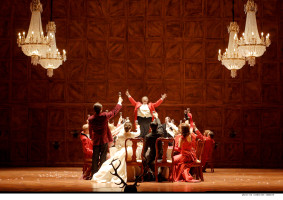Falstaff Stands Tall
|
Grant Chu Covell [January 2014.]
It had been a while since my last visit to the Metropolitan Opera’s red and gold candy box. I missed their newest opera, Nico Muhly’s Two Boys. Despite bafflement at other Muhly efforts, I had wanted to see this dark tale of murder and online chat rooms. I was fortunate to experience a Live in HD broadcast of The Nose earlier this season. I had previously caught William Kentridge’s staging of Shostakovich’s opera in person and was pleased that the Constructivist-inspired design translated well on the big screen. The HD broadcasts’ big appeal includes the pre-show and intermission features as well as the camera work. Should the stars align, I’ll catch Dvořák’s Rusalka. Wozzeck is also on later this season. Falstaff is the bonus opera of Verdi’s long career, a comedy capping the final string of dramas La forza del destino, Don Carlo, Aida and Otello. (It is also Verdi’s second comedy, after the early failure Un Giorno di Regno.) Librettist Arrigo Boito and Verdi started tossing around ideas as early as 1890. Boito trimmed Shakespeare’s Merry Wives of Windsor and borrowed from both parts of Henry IV to create something coherent and useful, excising characters and episodes, and of course inventing singable prose. Verdi was proud to say he wrote Falstaff to please himself, and even held off clueing in his publisher, Giulio Ricordi, until necessary. The composer was especially delighted to incorporate fugues into the work. On February 9, 1893, the six scenes in three acts were ready for the La Scala premiere. This season’s Falstaff shelves Franco Zeffirelli’s well-worn presentation for a new production shared between several companies: the Metropolitan Opera, Covent Garden’s Royal Opera, La Scala, Toronto’s Canadian Opera and De Nederlandse Opera. Robert Carsen has updated the opera to “in and around Royal Windsor, England, during the reign of Elizabeth II,” thus tentatively encroaching upon the 1950s. This may be the first non-modern opera I’ve seen which sensibly incorporates a radio nowhere near garishly like other productions that swap Orfeo’s lyre for a boombox. For a second or two I expected a Downton Abbey reference. Coffered walls suggest the Garter Inn scraped through WWII but has no hint of what’s around the corner. Act II, Scene II, at Ford’s house, is set in a wonderful mod Formica kitchen including a tubular dinette. Sir John’s clothes include a red hunting costume as if off a bottle of Johnnie Walker Red. Stag horns are another recurring visual motif. Verdi’s music suits the gentle slapstick. This production, taking its pace from stage and film, is far more energized than traditional productions or modern bare stages. Everywhere one sees engaging details and sight gags which I dare not ruin, except to recommend keeping a close eye on Bardolfo and Pistola’s dining room antics; note also how Mistress Quickly and Falstaff infuriate customers in the Inn’s salon. This production positions a single intermission between Acts II and III. Falstaff’s defenestration from the mammoth laundry basket into the Thames becomes the logical climax of the first four scenes. Act III suggests exteriors where nature and imagined fairies provide strong contrast as the action slows. This time I noticed modern touches I had not noted before, such as the curious progression of trilled chords imitating birds as wine revives Falstaff after his tumble into the river. By the time of Falstaff’s premiere, Wagner had been dead nearly ten years. The opera’s Munich premiere would be conducted by one of the next generation’s leading figures, Gustav Mahler. Richard Strauss had penned the first of his tone poems, and Brahms’ symphonies were behind him. Puccini’s Manon Lescaut premiered just eight days before in Turin, and Humperdinck’s Hansel and Gretel would arrive at the end of the year. On December 27, the 6’5” baritone Ambrogio Maestri, who will have achieved his 200th Falstaff portrayal in this run, ideally embodied the larger-than-life figure. Powerful throughout, his diction was clean and agile. While I admit to following along with the Met Titles, this was one of those performances where the acting alone made dialog clear. The Merry Wives included Jennifer Johnson Cano as Meg Page and Angela Meade as Alice Ford. Stephanie Blythe was wonderful as the resourceful Mistress Quickly. I was happy to hear Lisette Oropesa again (from La Rondine) in the role of Nannetta. Her Fenton was Paolo Fanale. Franco Vassallo appeared as Ford, humorously dressed as an American in the scene where he pretends to be Fontana. Keith Jameson and Christian Van Horn were Falstaff’s maligned retinue Bardolfo and Pistola. Carlo Bosi was the unfortunate Dr. Caius. The singers were as fine as could be imagined. Vassallo, who may have held back at the start of scenes, delivered when required. James Levine returned to the podium for this run to the audience’s adulation. He led the orchestra well, yet despite the speedy current, the music neither sparkled nor fully convinced. Wagner is different from Verdi in many respects; given what I’ve heard Levine do with Wagner, it disappointed to hear a less articulate Verdi, especially in the culminating fugue.
(Photo by Catherine Ashmore.)
[More Grant Chu Covell]
[More
Verdi]
[Previous Article:
Jürgen Jürgens’ Trauer-Ode]
[Next Article:
Used Bin Troll Tweets E.]
|
